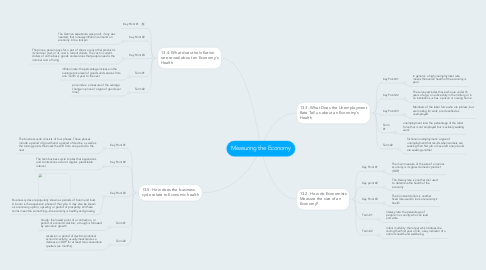
1. 13.4- What does the Inflation rate reveal about an Economy's Health
1.1. Key Point #1
1.2. Key Point #2
1.2.1. The German experience was proof, if any was needed, that runaway inflation can send an economy into a tailspin
1.3. Key Point #3
1.3.1. The price a person pays for a pair of shoes or any other product is its nominal cost, or its cost in current dollars. The cost in current dollars of all the basic goods and services that people need is the nominal cost of living
1.4. Term #1
1.4.1. inflation rate: the percentage increase in the average price level of goods and services from one month or year to the next
1.5. Term #2
1.5.1. price index: a measure of the average change in price of a type of good over time]
2. 13.5- How does the business cycle relate to Economic health
2.1. Key Point #1
2.1.1. The business cycle consists of four phases. These phases include a period of growth and a period of decline, as well as the turning points that mark the shift from one period to the next
2.2. Key Point #2
2.2.1. The term business cycle implies that expansions and contractions occur at regular, predictable interval
2.3. Key Point #3
2.3.1. Business cycles are popularly known as periods of boom and bust. A boom is the expansion phase of the cycle. It may also be known as a recovery, upturn, upswing, or period of prosperity. All these terms mean the same thing—the economy is healthy and growing
2.4. Term #1
2.4.1. trough: the lowest point of a contraction, or period of economic decline; a trough is followed by economic growth
2.5. Term #2
2.5.1. recession: a period of declining national economic activity, usually measured as a decrease in GDP for at least two consecutive quarters (six months)
3. 13.2- How do Economists Measure the size of an Economy?
3.1. Key Point #1
3.1.1. The main measure of the size of a nations economy is its gross domestic product (GDP)
3.2. Key point #2
3.2.1. The literacy rate is another tool used to determine the health of the economy
3.3. Key Point #3
3.3.1. The Constant dollars is another fixed rate used to look at economy's health
3.4. Term #1
3.4.1. literacy rate: the percentage of people in a country who can read and write.
3.5. Term #2
3.5.1. infant mortality: the rate at which babies die during their first year of life; a key indicator of a nation’s health and well-being
4. 13.3- What Does the Unemployment Rate Tell us about an Economy's Health
4.1. Key Point #1
4.1.1. In general, a high unemployment rate means the overall health of the economy is poor
4.2. Key Point #2
4.2.1. The survey excludes those who are under 16 years of age, on active duty in the military, or in an institution such as a prison or nursing home
4.3. Key Point #3
4.3.1. Members of the labor force who are jobless, but are looking for work, are classified as unemployed
4.4. Term #1
4.4.1. unemployment rate: the percentage of the labor force that is not employed but is actively seeking work
4.5. Term #2
4.5.1. frictional unemployment: a type of unemployment that results when workers are seeking their first job or have left one job and are seeking another
